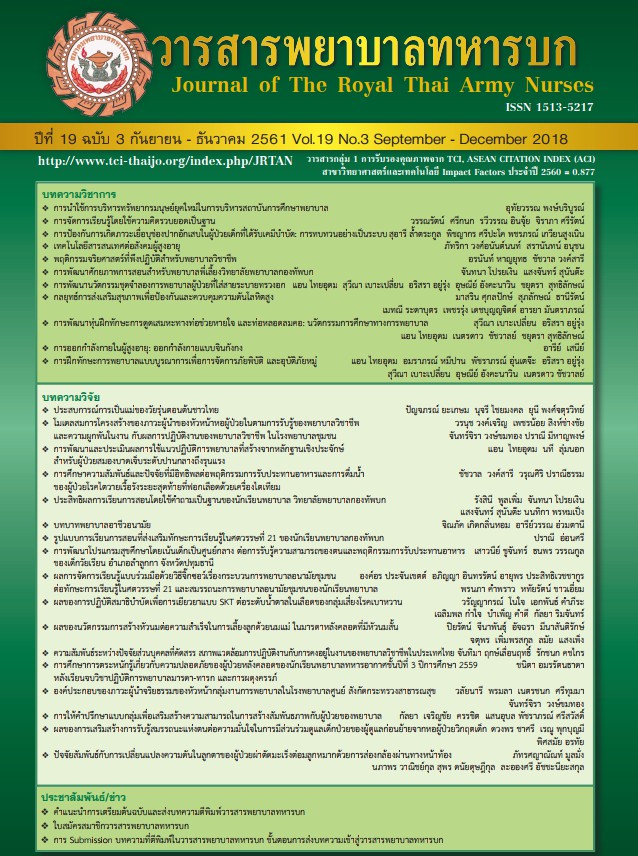การพัฒนาหุ่นฝึกทักษะการดูดเสมหะทางท่อช่วยหายใจ และท่อหลอดลมคอ: นวัตกรรมการศึกษาทางการพยาบาล
คำสำคัญ:
นวัตกรรม, หัตถการทางการพยาบาล, การดูดเสมหะทางท่อช่วยหายใจบทคัดย่อ
การดูดเสมหะทางท่อช่วยหายใจเป็นหัตถการทางการพยาบาลที่ทำบ่อยในทางคลีนิค และมีความจำเป็นอย่างยิ่งในการ ช่วยระบายเสมหะ เปิดทางเดินหายใจให้โล่ง ป้องกันการอุดกั้นทางเดินหายใจ โดยเฉพาะในผู้ป่วยวิกฤตหรือไม่สามารถไอขับเสมหะ ออกได้เองอย่างมีประสิทธิภาพ อย่างไรก็ตาม หัตถการดังกล่าวก็ทำให้เกิดภาวะแทรกซ้อนที่สำคัญได้หากขาดความรู้และทักษะการ พยาบาลในการดูดเสมหะทางท่อช่วยหายใจและท่อหลอดลมคออย่างถูกต้อง วิทยาลัยพยาบาลกองทัพบกเห็นความสำคัญในการ เตรียมความพร้อมทั้งในด้านความรู้ ทักษะและความมั่นใจในการปฏิบัติหัตถการต่างๆ รวมทั้งการดูดเสมหะให้แก่นักเรียนพยาบาล และนักเรียนผู้ช่วยพยาบาลก่อนฝึกปฏิบัติจริงกับผู้ป่วยในโรงพยาบาลเพื่อความปลอดภัยและลดความเสี่ยงให้แก่ผู้ป่วย แต่ทาง สถาบันขาดแคลนหุ่นที่ใช้ฝึกการดูดเสมหะทางท่อช่วยหายใจที่มีความเสมือนจริง จึงได้พัฒนาหุ่นฝึกหัตถการดังกล่าว เพื่อให้เป็น นวัตกรรมสื่อประกอบการสอนทักษะการพยาบาล และเปิดโอกาสให้นักเรียนมาใช้ฝึกทักษะความชำนาญในห้องฝึกปฏิบัติการได้ เมื่อต้องการ เพื่อพัฒนาประสิทธิภาพภาพการสอนทำหัตถการทางการพยาบาลและคุณภาพในการดูแลผู้ป่วยของนักเรียนพยาบาล จากผลการประเมินการใช้หุ่นฝึกดังกล่าว โดยนักเรียนพยาบาลชั้นปีที่ 2 รุ่นที่ 53 จำนวน 83 นาย และอาจารย์พยาบาลจำนวน 4 นาย พบว่า ระดับความพึงพอใจของผู้ใช้ทั้งโดยผู้เรียนผู้สอนอยู่ในระดับดีมาก ( = 4.7 และ 4.8 ตามลำดับ) หุ่นฝึกหัตถการนี้มี ประโยชน์สำหรับการเรียนการสอน ควบคู่ไปกับการเสริมความรู้ความเข้าใจในเชิงทฤษฎีเกี่ยวกับหลักการการดูดเสมหะที่ถูกต้อง โดยยึดจากหลักฐานเชิงประจักษ์ที่เป็นปัจจุบัน ภาวะความเสี่ยงที่ต้องเฝ้าระวัง และแนวทางในการผู้ป่วยทั้ง ก่อน ขณะ และหลัง การดูดเสมหะทางท่อช่วยหายใจที่ถูกต้อง
Downloads
เอกสารอ้างอิง
2. Boonchoochuay R. Innovative Suction Training “RTAFNC Suction Model.” Journal of The Police Nurse. 2015; 7(1): 45-52. (in Thai)
3. Javadi M, Hejr H, Zolad M, Khalili A, Paymard A. Comparing the effect of endotracheal tube suction using open method with two different size catheters 12 and 14 on discharge secretion, pain, heart rate, blood pressure, and arterial oxygen saturation of patients in the intensive care unit: A randomized clinical trial. Annals of Tropical Medicine and Public Health. 2017;10(5):1312.
4. American Association for Respiratory C. AARC Clinical Practice Guidelines. Endotracheal suctioning of mechanically ventilated patients with artificial airways 2010. Respiratory care. 2010;55(6):758.
5. Negro A, Ranzani R, Villa M, Manara D. Survey of Italian intensive care unit nurses’ knowledge about endotracheal suctioning guidelines. Intensive & Critical Care Nursing. 2014;30(6): 339-45.
6. Bülbül Maraş G, Kocaçal Güler E, Eşer İ, Köse Ş. Knowledge and practice of intensive care nurses for endotracheal suctioning in a teaching hospital in western Turkey. Intensive & Critical Care Nursing. 2017;39:45-54.
7. Billings L, Allen P, Armstrong M, Green A. Creating and launching. Innovative nursing education programs: perils and pearls. Nursing education perspectives. 2012;33(5):292-6.
8. Oermann MH. Technology and Teaching Innovations in Nursing Education: Engaging the Student. Nurse Educator. 2015;40(2):55-6.
9. Körükcü Ö, Kukulu K. Innovation in nursing education. Procedia - Social and Behavioral Sciences. 2010;9:369-72.
10. Ricketts B. The role of simulation for learning within pre-registration nursing education — A literature review. Nurse Education Today. 2011;31(7):650-4.
11. Johnson MP, Hickey KT, Scopa-Goldman J, Andrews T, Boerem P, Covec M, et al. Manikin Versus Web-Based Simulation for Advanced Practice Nursing Students. Clinical Simulation in Nursing. 2014;10(6):e317-e23.
12. Foronda C, Liu S, Bauman EB. Evaluation of Simulation in Undergraduate Nurse Education: An Integrative Review. Clinical Simulation in Nursing. 2013;9(10):e409-e16.
13. Shin S, Park J-H, Kim J-H. Effectiveness of patient simulation in nursing education: Meta-analysis. Nurse Education Today. 2015;35(1):176-82.
14. Rovamo LM, Mattila M-M, Andersson S, Rosenberg PH. Testing of midwife neonatal resuscitation skills with a simulator manikin in a low-risk delivery unit: Midwife neonatal resuscitation skills. Pediatrics International. 2013;55(4): 465-71.
15. Cant RP, Cooper SJ. Simulation-based learning in nurse education: systematic review. Journal of Advanced Nursing. 2010;66(1):3-15.
16. Wongprach B. & Poomsanguan K. Innovation Development of The Army Nurse Condom Ring for male patient : Applying a drainage condom. Journal of The Royal Thai Army Nurse. 2017;19(1):55-65. (in Thai)
ดาวน์โหลด
เผยแพร่แล้ว
รูปแบบการอ้างอิง
ฉบับ
ประเภทบทความ
สัญญาอนุญาต
บทความหรือข้อคิดเห็นใดใดที่ปรากฏในวารสารพยาบาลทหารบกเป็นวรรณกรรมของผู้เขียน ซึ่งบรรณาธิการหรือสมาคมพยาบาลทหารบก ไม่จำเป็นต้องเห็นด้วย
บทความที่ได้รับการตีพิมพ์เป็นลิขสิทธิ์ของวารสารพยาบาลทหารบก
The ideas and opinions expressed in the Journal of The Royal Thai Army Nurses are those of the authors and not necessarily those
of the editor or Royal Thai Army Nurses Association.







